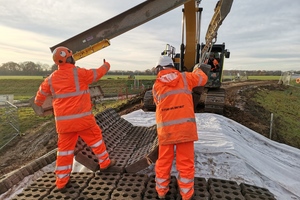River Aire flood defences are winter ready as work continues on permanent repairs
Press release
Permanent repairs to flood embankments on the lower River Aire are underway after they were damaged during storms last winter.

Reinforcing the embankment at Poor Bank
The repairs form part of a £10M package of work that will reduce flood risk to communities across North Yorkshire and the East Riding of Yorkshire including Snaith and Gowdall.
Emergency temporary repairs were carried out in the immediate aftermath of the flooding, but now permanent works at locations across the Lower Aire Washlands will repair the damage caused and strengthen defences.
The latest repairs are being completed at Pick Hill embankment near Snaith and Poor Bank embankment near Gowdall where concrete blocks are being installed to make them more resilient to future scour damage if a similar flood was to happen again.
Poor bank and Pickhill embankments are part of reservoirs that help reduce the flood risk to the communities of Gowdall and Snaith.
Kimberley MacPherson, West Yorkshire Operations Manager at the Environment Agency said:
It was the wettest February on record for Yorkshire, with the River Aire catchment receiving three and a half times the average monthly rainfall.
The floods had a devastating impact on communities across North Yorkshire, and our thoughts remain with those affected, especially families who still cannot return home.
After the flood water subsided, we inspected defences in the area and found damage at 40 locations. We secured £10 million of funding to make repairs and have been working hard to complete them ahead of winter. Where permanent fixes won’t be complete by spring, we’ve installed temporary measures to ensure local communities are protected this winter.
We can never entirely eliminate the risk of flooding. We encourage people to prepare too, by signing up for Flood Warnings and preparing a flood plan. Further information can be found on GOV.UK.
-
Repair work has already been completed at Little Airmyn, West Holme, with West Haddlesey due for completion next week.
-
Repairs at Pick Hill are complete, and final landscaping at Poor Bank is due to be completed by Christmas.
-
Ground investigation works around areas such as Chapel Haddlesey, Birkin Barrier, Hensall Ings, Hensall Pumping Station, Carlton Bridge and Lock Lane, have now finished, so design work has now started to plan what work is needed for these areas.
-
Work at two sites at Hirst Courtney will start early next year and will see repairs to flood embankments in the village and work to prevent river channel erosion near The Sloop Inn pub.
-
A new flood defence wall is being proposed at Newlands, with work due to start next year. Temporary repairs are in place for the winter period until permanent works can start.
-
At Heck Ings, work is being planned for scour damage and seepage repairs with work due to start in the new year.
Since the February floods, the Environment Agency has been working closely with North Yorkshire County Council, East Riding of Yorkshire Council and the Internal Drainage Board to learn from the floods and plan for the future.
Work has been done with communities to help them become better prepared for any risk of flooding, with improvements made to flood warning and informing, and the recruitment of community flood wardens.
Published 10 December 2020
